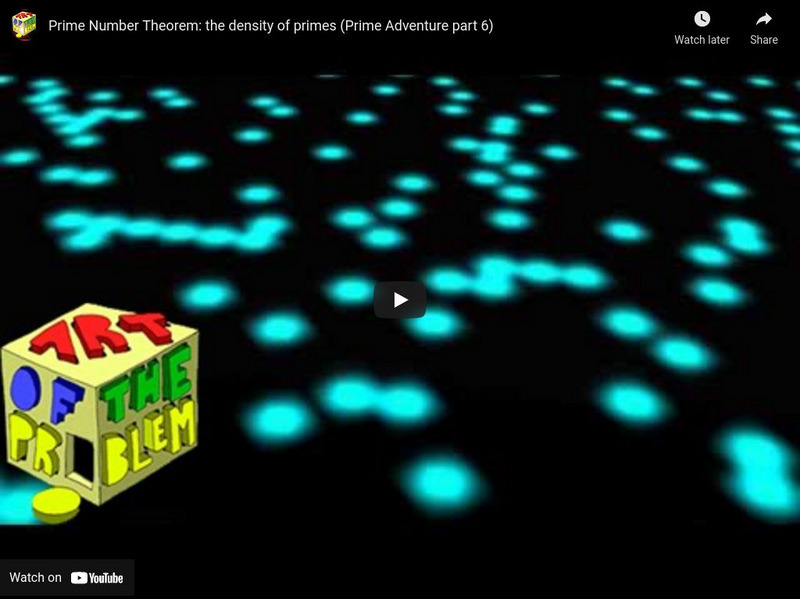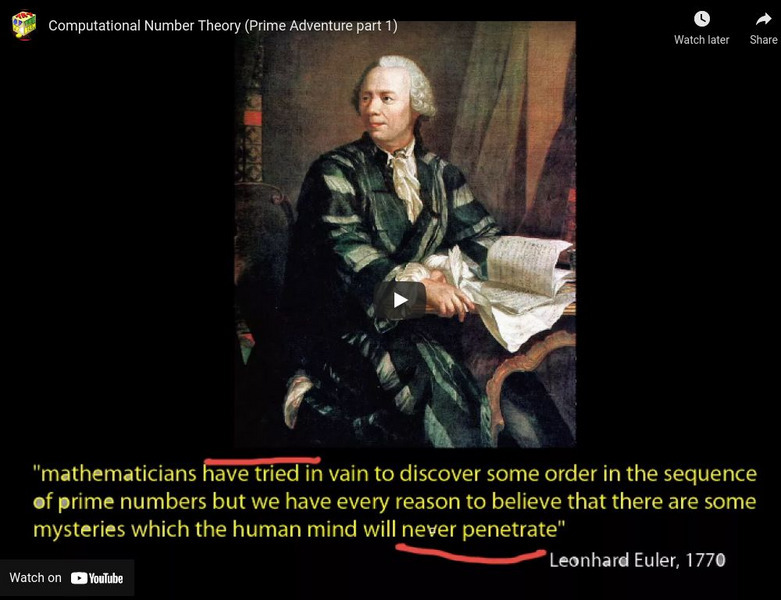Hi, what do you want to do?
Curated OER
Prime Numbers Sieve
A very quick look at a multiplication table and how to eliminate numbers according to multiples of 2,3, 5, and 7. After eliminating these multiples, the numbers you are left with are prime.
Curated OER
What's Another Definition for Prime and Composite Numbers?
Simply put, a prime number is a number that is divisible only by one and itself. All other numbers are composite.
Curated OER
What's a Prime Polynomial?
The instructor defines a prime polynomial as much the same as a prime number: they only have two factors, 1 and itself. She further demonstrates what a composite polynomial is to give an example of a polynomial that is not prime.
Math Playground
What is Prime Factorization?
A teacher describes how to find the prime factors of 525. She starts by describing how to use a factor tree to describe the factors of a number. Next, she uses increasingly difficult examples to illustrate this concept.
Math Playground
How Do You Find GCF and LCM?
Using the numbers 225 and 270, the narrator explains how to find the greatest common factor and the least common multiple. This presentation could be used in conjunction with other videos in a series exploring how to identify prime...
Math Playground
What is a Prime Number?
Review the characteristics of prime numbers. The narrator begins by defining factors and then goes on to explore the definition of prime numbers. This is a quick and easy way to review prime numbers.
Khan Academy
MTEL Math Practice Test: 12-15
This video discusses prime factorization and prime or natural numbers. Sal shows viewers how to solve these problems and one with expressions representing a given volume.
Curated OER
Prime Numbers Stop Action
A stop action video demonstrating how 2,3, 5, 7, and 11 are prime numbers. There is no dialogue in the video so the class has to pay attention and be able to read to follow the video. I recommend playing the music on low volume so as not...
Curated OER
Prime Numbers Song
Prime numbers are very special numbers. This clip defines what a prime number is and then provides a song to help students remember what they are. This could be a very helpful teaching strategy for kinesthetic learners. Music builds memory.
Curated OER
Prime Numbers Explained
Rushton explains prime and composite numbers by showing what numbers can be multiplied to get the numbers 1 - 11. He also explains that 0 and 1 are special numbers.
Sophia Learning
Sophia: Factoring Monomials: Lesson 2
This lesson will cover how to factor the coefficient separately from each variable in order to factor a monomial. It is 2 of 11 in the series titled "Factoring Monomials."
Virtual Nerd
Virtual Nerd: How Do You Factor a Greatest Common Factor Out of an Expression
Knowing how to find the Greatest Common Factor (GCF) is crucial to solving an equation or simplifying an expression. Review for the SAT by watching this tutorial that walks you through the process. [4:57]
Annenberg Foundation
Annenberg Learner: Mathematics Illuminated: The Primes
A detailed look at the importance of prime numbers, not only in math, but also in science and in the field of cryptography. [28:27]
Khan Academy
Khan Academy: Arithmetic and Pre Algebra: Recognizing Prime Numbers
This video solves a problem asking to determine whether presented numbers are prime, composite, or neither. Practice problems are available. [4:40]
Khan Academy
Khan Academy: Arithmetic and Pre Algebra: Prime Factorization
This video shows how to find the prime factorization of a two-digit number and write the answer in exponential notation. Practice problems available. Practice problems are available. [4:09]
Sophia Learning
Sophia: Factoring Monomials: Lesson 11
This lesson will cover how to factor the coefficient separately from each variable in order to factor a monomial. It is 11 of 11 in the series titled "Factoring Monomials."
Sophia Learning
Sophia: Factoring Monomials: Lesson 7
This lesson will cover how to factor the coefficient separately from each variable in order to factor a monomial. It is 7 of 11 in the series titled "Factoring Monomials."
Khan Academy
Khan Academy: Computational Number Theory: The Prime Number Theorem
How can we estimate the number of primes up to x?
Khan Academy
Khan Academy: Computational Number Theory: Algorithmic Efficiency
How can we improve the speed of a (deterministic) primality test?
Khan Academy
Khan Academy: Computational Number Theory: Primality Test
Setting up the problem of a primality test.
Khan Academy
Khan Academy: Computational Number Theory: Primality Test With Sieve
An attempt at an optimal trial division primality test using the Sieve of Eratosthenes.
Khan Academy
Khan Academy: Computational Number Theory: Summary (What's Next?)
Why is factorization hard, yet generating primes easy? Where do we go from here?
Khan Academy
Khan Academy: Computational Number Theory: Time Space Tradeoff
What is our memory limit? How can save time at the expense of space?
Khan Academy
Khan Academy: Randomized Algorithms: Random Primality Test (Warm Up)
Introduction to random primality tests & how they will work (warm up).




























